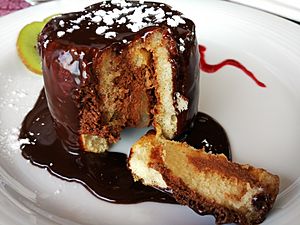Charlotte (cake) facts for kids

Chocolate and pear charlotte, with the typical ladyfinger biscuits clearly seen.
|
|
| Alternative names | Ice-box cake |
|---|---|
| Course | Dessert |
| Place of origin | England?, France? |
| Serving temperature | Hot or cold |
| Main ingredients | Bread, sponge cake or biscuits; fruit puree or custard |
| Variations | Charlotte russe |
A charlotte is a delicious dessert that can be served warm or cold. Some people also call it an "icebox cake". To make a charlotte, a mold is lined with bread, sponge cake, or biscuits (like cookies). Then, the mold is filled with a tasty fruit puree (like mashed fruit) or a creamy custard. Sometimes, it can even be made with layers of breadcrumbs.
A special type of charlotte, called Charlotte russe, uses a mold lined with soft ladyfinger biscuits. This mold is then filled with a light and fluffy Bavarian cream.
In the past, people often used slightly stale bread dipped in butter to line the mold. But today, it's more common to use sponge cake or ladyfingers. The yummy filling inside can also be topped with a thin layer of gelatin that matches the flavor.
Contents
The History of Charlotte Desserts
Have you ever wondered where the charlotte dessert came from? Its exact beginnings are a bit of a mystery!
A famous French chef named Marie-Antoine Carême said he invented a version called charlotte à la parisienne around 1803. He was a very important chef who cooked for kings and queens.
One of the first known recipes for a charlotte in English was published in London in 1808. It was in a cookbook called New System of Domestic Cookery by Maria Rundell. This early recipe described how to make a charlotte with thin slices of bread and apples.
Chef Carême mentioned many different kinds of charlottes in his 1815 cookbook. He had charlottes made with apples, apricots, peaches, and even vanilla. He also noted that what he called charlotte à la parisienne was often called charlotte à la russe by others.
Different Kinds of Charlotte Desserts
There are many exciting ways to make a charlotte! Most charlottes are served cool, which makes them perfect for warmer weather.
- Fruit Charlottes: These often mix a fruit puree or jam, like raspberry or pear, with a creamy custard or whipped cream.
- Chocolate Charlottes: These are made with layers of rich chocolate mousse filling.
- Algerian Charlotte: This unique charlotte is made with honey, sweet dates, orange peel, and almonds.
- Russian Sharlotka: In the 19th century, a Russian dessert called sharlotka was a baked pudding with layers of brown bread and apple sauce. Today, it's often a simpler dessert of chopped apples baked in a sweet batter.
Charlotte Russe
The Charlotte russe (which means "Russian charlotte" in French) is a cold dessert. It's made by setting Bavarian cream inside a mold that is lined with ladyfingers.
In New York City during the 1930s, 1940s, and 1950s, a simpler version of charlotte russe was a very popular treat. It was sold in candy stores and luncheonettes. This version came in a paper cup filled with yellow cake and whipped cream, topped with half a bright red maraschino cherry. You would push up the bottom of the cup to eat it!
Another fun variation is the Charlotte royale. It uses the same creamy filling as a Charlotte russe, but instead of ladyfingers, it's lined with slices of Swiss roll cake.
Where Did the Name "Charlotte" Come From?
The name "charlotte" for this dessert first appeared in a New York magazine in 1796. How it got its name isn't completely clear.
Some people think it might have been named after a woman. Others suggest it comes from an Old English word, charlyt, which was a type of custard. It might also be linked to charlets, which was a meat dish.
It's often said that Chef Carême named the charlotte after a royal person he served. However, the name "charlotte" was used years before he became famous. Carême himself preferred to call charlotte à la russe by the name charlotte à la parisienne. He even mentioned that "others" liked to call it russe. So, it's unlikely he named it after Czar Alexander I of Russia, as some stories suggest.
See also
 In Spanish: Carlota (postre) para niños
In Spanish: Carlota (postre) para niños

